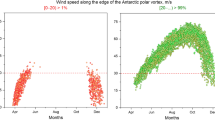Abstract
Stability of the stratospheric polar vortex in the winter–spring period is one of key factors of the duration and scales of stratospheric ozone depletion in a polar region. The Arctic polar vortex attains its peak intensity in winter, whereas the Antarctic vortex usually strengthens in early spring. As a result, large-scale ozone depletion occurs every year from August to November over the Antarctic, and short-term ozone loss occasionally occurs from January to March over the Arctic. In this work, we analyze the reason for the high strength and stability of the Antarctic polar vortex in the winter–spring period. A good agreement between the seasonal variations in the temperature of the subtropical lower stratosphere and in the zonal wind in the lower subpolar and polar stratosphere in the Southern Hemisphere is shown on the basis of ERA-Interim reanalysis data. The results of numerical simulations with the PlaSim-ICMMG-1.0 model show acceleration of zonal wind in the subpolar region with an increase in the temperature of the subtropical stratosphere. Thus, the winter–spring strengthening of the Antarctic polar vortex occurs due to an increase in the stratospheric equator-to-pole temperature gradient caused by the seasonal increase in the temperature of the lower subtropical stratosphere in this period.


Similar content being viewed by others
REFERENCES
D. W. Waugh and W. J. Randel, “Climatology of Arctic and Antarctic polar vortices using elliptical diagnostics,” J. Atmos. Sci. 56 (11), 1594–1613 (1999).
D. W. Waugh and L. M. Polvani, “Stratospheric polar vortices,” in The Stratosphere: Dynamics, Transport, and Chemistry. Geophysical Monograph Series (American Geophysical Union, 2010), vol. 190, p. 43–57.
P. A. Newman, “Chemistry and dynamics of the antarctic ozone hole,” in The Stratosphere: Dynamics, Transport, and Chemistry. Geophysical Monograph Series (American Geophysical Union, 2010), vol. 190, p. 157–171.
S. Solomon, R. R. Garcia, F. S. Rowland, and D. J. Wuebbles, “On the depletion of antarctic ozone,” Nature 321, 755–758 (1986).
P. A. Newman, S. R. Kawa, and E. R. Nash, “On the size of the antarctic ozone hole,” Geophys. Rev. Lett. 31 (21), L21104 (2004).
S. Solomon, “Stratospheric ozone depletion: A review of concepts and history,” Rev. Geophys. 37 (3), 275–316 (1999).
G. L. Manney and R. W. Zurek, “On the motion of air through the stratospheric polar vortex,” J. Atmos. Sci. 51 (20), 2973–2994 (1994).
A. H. Sobel, R. A. Plumb, and D. W. Waugh, “Methods of calculating transport across the polar vortex edge,” J. Atmos. Sci. 54 (18), 2241–2260 (1997).
B. J. Finlayson-Pitts and J. N. Pitts, Chemistry of the Upper and Lower Atmosphere: Theory, Experiments, and Applications (Academic Press, California, 2000).
D. W. Waugh, A. H. Sobel, and L. M. Polvani, “What is the polar vortex and how does it influence weather?,” Bull. Am. Meteorol. Soc. 98 (1), 37–44 (2017).
S. Driscoll, A. Bozzo, L. J. Gray, A. Robock, and G. Stenchikov, “Coupled Model Intercomparison Project 5 (CMIP5) simulations of climate following volcanic eruptions,” J. Geophys. Res. D. 117 (17), D17105 (2012).
V. V. Zuev and E. Savelieva, “The cause of the spring strengthening of the antarctic polar vortex,” Dynam. Atmos. Oceans 87, 101097 (2019).
D. P. Dee, S. M. Uppala, A. J. Simmons, P. Berrisford, P. Poli, S. Kobayashi, U. Andrae, M. A. Balmaseda, G. Balsamo, P. Bauer, P. Bechtold, A. C. M. Beljaars, L. van de Berg, J. Bidlot, N. Bormann, C. Delsol, R. Dragani, M. Fuentes, A. J. Geer, L. Haimberger, S. B. Healy, H. Hersbach, E. V. Holm, L. Isaksen, P. Kallberg, M. Kohler, M. Matricardi, A. P. McNally, B. M. Monge-Sanz, J.-J. Morcrette, B.-K. Park, C. Peubey, P. de Rosnay, C. Tavolato, J.-N. Thepaut, and F. Vitart, “The ERA-Interim reanalysis: Configuration and performance of the data assimilation system,” Q. J. Roy. Meteor. Soc 137 (656), 553–597 (2011).
V. V. Zuev and E. Savelieva, “The cause of the strengthening of the antarctic polar vortex during october-november periods,” J. Atmos. Sol.-Terr. Phys. 190, 1–5 (2019).
G. Platov, V. Krupchatnikov, Yu. Martynova, I. Borovko, and E. Golubeva, “A new Earth’s climate system model of intermediate complexity, PlaSim-ICMMG-1.0: Description and performance,” Earth Env. Sci. 96, 12 005 (2017).
Funding
The study was carried out within the framework of state budgetary theme no. AAAA-A17-117013050038-7 and Fundamental Research Program no. 0315-2019-0003.
Author information
Authors and Affiliations
Corresponding authors
Ethics declarations
The authors declare that they have no conflict of interest.
Rights and permissions
About this article
Cite this article
Zuev, V.V., Borovko, I.V., Krupchatnikov, V.N. et al. Influence of the Temperature of the Lower Subtropical Stratosphere on Antarctic Polar Vortex Dynamics. Atmos Ocean Opt 33, 708–711 (2020). https://doi.org/10.1134/S1024856020060160
Received:
Revised:
Accepted:
Published:
Issue Date:
DOI: https://doi.org/10.1134/S1024856020060160




